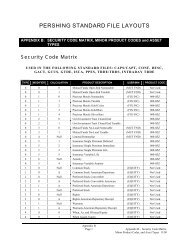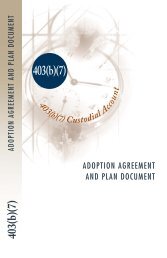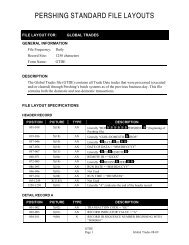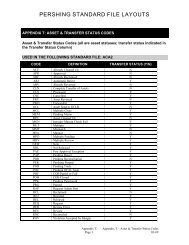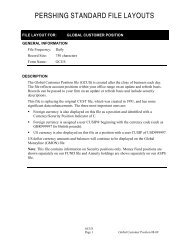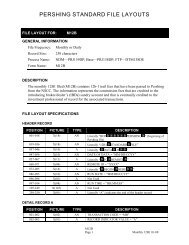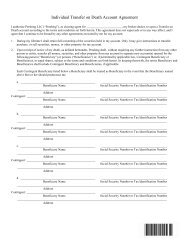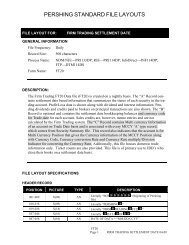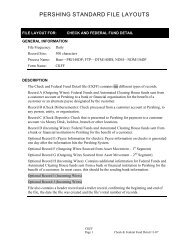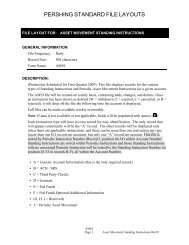Qualified Plan Participant Distribution Form
Qualified Plan Participant Distribution Form
Qualified Plan Participant Distribution Form
You also want an ePaper? Increase the reach of your titles
YUMPU automatically turns print PDFs into web optimized ePapers that Google loves.
QUALIFIED RETIREMENT PLAN<br />
DISTRIBUTION REQUEST<br />
The Employee Retirement Income Security Act of 1974 (ERISA) requires that you<br />
receive the information contained in this form prior to your annuity start date or<br />
distribution date.<br />
The <strong>Distribution</strong> Request form must be completed by you, or by you and your<br />
employer, if applicable. The choices that you select will determine the method of<br />
payment and can influence the amount of tax that you pay.<br />
In addition to providing your account number, Social Security Number (or Tax I.D.<br />
Number), date of birth and the address to mail the check, you must indicate the<br />
following:<br />
• Whether or not you would like to directly rollover your distribution to an<br />
IRA (if applicable) and thereby avoid the mandatory 20 percent<br />
federal and applicable state income tax withholding.<br />
• Type of <strong>Distribution</strong> (Normal, early, etc.).<br />
• Frequency of <strong>Distribution</strong> (Periodic, or one time).<br />
• Annuity Waiver and Spousal Consent, if required.<br />
• Withholding Election for assets that do not require mandatory<br />
federal or state income tax withholding.<br />
Please read the attached instructions, which explain your options in detail. We<br />
suggest that you consult with a competent tax advisor before completing this form.<br />
(Page 1 of 6)
INSTRUCTIONS<br />
(Please Read Before Completing <strong>Form</strong>)<br />
In order for a distribution to be made under the <strong>Plan</strong> or 403(b)(7) Custodial Account, a distribution request form must be completed,<br />
signed by the participant, and, if necessary, signed by the employer. In certain cases the form must also be signed before a Notary<br />
Public by the participant’s spouse.<br />
General Rules<br />
Several special tax rules apply to distributions from <strong>Qualified</strong> Retirement <strong>Plan</strong>s and 403(b)(7) Custodial Accounts, and participants<br />
are urged to consult their tax advisor regarding their own specific situation.<br />
<strong>Qualified</strong> Retirement <strong>Plan</strong>s: Section Six of the Basic <strong>Plan</strong> Document for <strong>Qualified</strong> Retirement <strong>Plan</strong>s defines distributions. The<br />
distribution rules for <strong>Qualified</strong> <strong>Plan</strong>s generally state that unless the <strong>Qualified</strong> <strong>Plan</strong> is being terminated by the employer (or<br />
self-employed individual) and all the assets in the <strong>Plan</strong> are being distributed to participants, or all assets are being transferred to<br />
a new trustee or custodian, no distribution of a participant’s account is permitted unless the participant has ceased working in the<br />
employer’s business by reason of disability, death, or termination of employment; has attained normal retirement age; or in-service<br />
withdrawals (including hardship withdrawals) are permitted in the adoption agreement of a Profit Sharing <strong>Plan</strong> or a 401(k) <strong>Plan</strong>.<br />
403(b)(7) Custodial Accounts: Section 4 of the 403(b)(7) Custodial Account Agreement dictates the limits on distributions.<br />
Generally, distributions are not permitted unless the participant attains the age of 59 1 ⁄2 years; incurs a disability that permanently<br />
prevents gainful employment; dies; incurs certain financial hardships; or terminates employment with the employer specified in the<br />
Adoption Agreement. Account values immediately preceding 1989 are generally not subject to these distribution limitations.<br />
Required Minimum <strong>Distribution</strong>s<br />
<strong>Distribution</strong>s generally must commence by the April 1 following the calendar year the participant attained the age of 70 1 ⁄2 years unless<br />
still employed, and not a 5 percent owner. In addition, if a lump sum distribution of the entire account balance is not elected by such<br />
a participant, a minimum amount must be distributed each year to avoid a 50 percent excise tax penalty. Periodic distributions may<br />
not be paid over a period extending beyond the life expectancy of the participant or the joint life expectancy of the participant and<br />
his/her beneficiary. IRS Publication 939 contains the tables under which life expectancy is determined. In the event of the death of<br />
the participant, additional rules apply. Each participant is urged to consult their own tax advisor about all the tax rules that apply to<br />
distributions from the <strong>Plan</strong>. A 403(b)(7) participant need not include pre-1987 amounts in the required minimum distribution formula<br />
until the calendar year he or she attains the age of 75 years.<br />
<strong>Distribution</strong> Options<br />
As required by law, the normal form of distribution of a <strong>Qualified</strong> Retirement <strong>Plan</strong>, or a 403(b)(7) Custodial Account governed by the<br />
terms of ERISA, is an annuity for the life of an unmarried participant, or for a married participant, a joint and survivor annuity for the<br />
joint and last survivor life of the participant and the participant’s spouse. For an unmarried participant, a lump sum distribution or<br />
periodic distributions over a period not extending beyond the life expectancy of the participant (or the joint life expectancy of the<br />
participant and his/her beneficiary) may be elected, provided the amount distributed each year meets certain minimum distribution<br />
rules. For a married participant, these choices may only be elected if the spouse consents in writing to such an election and such<br />
consent is notarized, or the Safe Harbor provisions of Section 6.05(f) of the basic plan document have been elected in the adoption<br />
agreement of a Profit Sharing <strong>Plan</strong>. All participants are urged to consult their own tax advisor as to the application to their own<br />
situation of all the tax rules relating to <strong>Plan</strong> distributions. <strong>Distribution</strong>s from 403(b)(7) Custodial Accounts that are not subject to the<br />
terms of ERISA may be made in a single lump sum payment, or in periodic payments that do not extend beyond the joint life and<br />
survivor expectancy of the participant and beneficiary.<br />
I. QUALIFIED JOINT SURVIVOR ANNUITY<br />
Unless properly waived, you will receive your vested account balance in the form of a <strong>Qualified</strong> Joint and Survivor Annuity.<br />
A. <strong>Qualified</strong> Joint and Survivor Annuity Defined<br />
If you are married, a <strong>Qualified</strong> Joint and Survivor Annuity is a series of periodic payments to you during your lifetime and to<br />
your spouse upon your death. The periodic payment amount your spouse receives will be a set percentage of the periodic<br />
payment amount you received during your lifetime. To determine the percentage your spouse would receive (i.e., Survivor<br />
Annuity), contact the plan administrator (employer).<br />
A <strong>Qualified</strong> Joint and Survivor Annuity for a participant who is not married is a series of annuity payments for the life of the<br />
participant.<br />
If your vested account balance is $5,000 or less at the time of the distribution, the plan administrator has the right to pay your<br />
distribution to you in a single cash payment. If your vested account balance exceeds $5,000, you must consent to the form<br />
of payment.<br />
B. Waiving the <strong>Qualified</strong> Joint and Survivor Annuity<br />
If you wish to receive your vested account balance using one of the other options listed, you (and, if you are married, your<br />
spouse) must waive the <strong>Qualified</strong> Joint and Survivor Annuity. You can waive the <strong>Qualified</strong> Joint and Survivor Annuity by<br />
completing this <strong>Distribution</strong> Request form. After waiving the <strong>Qualified</strong> Joint and Survivor Annuity by signing this <strong>Distribution</strong><br />
Request form, you may receive your vested account balance using one of the other distribution methods explained below.<br />
C. Financial Effect of a <strong>Qualified</strong> Joint and Survivor Annuity<br />
As stated above, a <strong>Qualified</strong> Joint and Survivor Annuity will provide periodic payments to you during your lifetime and, if you<br />
are married, to your spouse after your death. Your spouse will generally receive smaller periodic payments than you received<br />
(Page 2 of 6)
while you were alive. For example, assume a participant retires with a $10,000 vested account balance. A <strong>Qualified</strong> Joint<br />
and Survivor Annuity would provide him or her with the following payments:<br />
Lifetime Monthly<br />
Monthly<br />
<strong>Participant</strong> Benefit % of Survivor Annuity* Survivor Benefit<br />
$63.40 100.00% $63.40<br />
$66.30 75.00% $49.72<br />
$67.30 66.67% $44.86<br />
$69.40 50.00% $34.70<br />
*These estimates are derived from standard mortality tables using a participant with a 65 year old spouse beneficiary<br />
beginning payments at the age of 65 years. To determine the survivor annuity percentage, contact the plan administrator<br />
(usually the employer).<br />
II. LUMP SUM PAYMENT<br />
If you properly waive the <strong>Qualified</strong> Joint and Survivor Annuity, you may receive your entire vested account balance<br />
in one lump sum.<br />
A. Lump Sum Payment Defined<br />
A Lump Sum Payment is the payment of your entire vested account balance.<br />
B. Financial Effect and Tax Consequences of a Lump Sum Payment<br />
Generally, a Lump Sum Payment is included in your income and taxed in the year of the distribution. There are three<br />
exceptions to this general tax rule.<br />
1. Rollover<br />
You may avoid immediate taxation on the taxable portion of a lump sum payment if you roll the eligible dollars over into<br />
another <strong>Qualified</strong> Retirement <strong>Plan</strong>, 403(b)(7) Custodial Account, or individual retirement arrangement (IRA).<br />
Note: An eligible rollover distribution from a 403(b)(7) Custodial Account may be rolled only to an IRA or to another<br />
403(b) <strong>Plan</strong> or 403(b)(7) Custodial Account.<br />
A payment that is eligible for “rollover” can be taken in two ways. You have all or any portion of your payment either<br />
1) PAID IN A “DIRECT ROLLOVER” or 2) PAID TO YOU. A rollover is a payment of your <strong>Plan</strong> or Custodial Account<br />
benefits to your IRA or to another <strong>Qualified</strong> Retirement <strong>Plan</strong> or 403(b)(7) Custodial Account. The choice will affect the<br />
tax you owe.<br />
If you choose a DIRECT ROLLOVER:<br />
• Your payment will not be taxed in the current year and no income tax will be withheld.<br />
• Your payment will be made directly to your IRA, or if you choose, to another employer <strong>Qualified</strong> Retirement <strong>Plan</strong> or<br />
403(b)(7) Custodial Account that accepts your rollover.<br />
• Your payment will be taxed later when you take it out of the IRA, <strong>Qualified</strong> Retirement <strong>Plan</strong>, or 403(b)(7) Custodial<br />
Account.<br />
If you choose to have your <strong>Plan</strong> benefits PAID TO YOU:<br />
• You will receive only 80 percent or less of the payment because the <strong>Plan</strong> administrator is required to withhold 20<br />
percent of the payment for federal income taxes and send it to the IRS as income tax withholding to be credited<br />
against your federal income taxes. State income tax withholding may also apply to your distribution.<br />
• Your payment will be taxed in the current year unless you roll it over. However, if you receive the payment before the<br />
age of 59 1 ⁄2 years, you also may have to pay an additional 10 percent tax.<br />
• You can roll it over to your IRA, or to another employer <strong>Qualified</strong> Retirement <strong>Plan</strong>, or 403(b)(7) Custodial Account that<br />
accepts your rollover, within 60 days of receiving the payment. The amount rolled over will not be taxed until you take<br />
it out of the IRA, <strong>Qualified</strong> Retirement <strong>Plan</strong>, or 403(b)(7) Custodial Account.<br />
• If, within 60 days of receiving your distribution, you want to roll over 100 percent of the payment to an IRA, <strong>Qualified</strong><br />
Retirement <strong>Plan</strong>, or 403(b)(7) Custodial Account, you must find other money to replace the 20 percent that was<br />
withheld for federal income taxes and the amount withheld for state income taxes, if any. If you roll over the net amount<br />
you received, you will be taxed on the withheld amount that is not rolled over.<br />
Payments from the <strong>Qualified</strong> Retirement <strong>Plan</strong> or 403(b)(7) Custodial Account may be “eligible rollover distributions.” This<br />
means that they can be rolled over to our Custodial IRA, <strong>Qualified</strong> Retirement <strong>Plan</strong>, or 403(b)(7) Custodial Account or a<br />
similar IRA, plan, or custodial account at another qualified custodian, or to another employer <strong>Qualified</strong> Retirement <strong>Plan</strong><br />
that accepts rollovers. Your <strong>Plan</strong> administrator or employer should be able to tell you what portion of your payment is an<br />
eligible rollover distribution. The following types of payments cannot be rolled over:<br />
Non-taxable Payments. In general, only the “taxable portion” of your payment is an eligible rollover distribution. If you<br />
have made “after-tax” employee contributions to the <strong>Plan</strong>, these contributions will be non-taxable when they are paid to<br />
you, and they cannot be rolled over. (After-tax employee contributions generally are contributions you made from your<br />
own pay that were already taxed.)<br />
Payments Spread Over Long Periods. You cannot roll over a payment if it is part of a series of equal (or almost equal)<br />
payments that are made at least once a year and that will last for:<br />
• your lifetime (or your life expectancy), or<br />
• your lifetime and your beneficiary’s lifetime (or life expectancies), or<br />
• a period of ten years or more.<br />
Required Minimum Payments. Beginning in the year you reach the age of 70 1 ⁄2 years unless still employed and not a 5<br />
percent owner, (or the age of 75 years for 403(b)(7) participants with determinable pre-1987 amounts) a certain portion<br />
of your payment cannot be rolled over because it is a “required minimum payment” that must be paid to you.<br />
(Page 3 of 6)
2. Ten-Year Averaging If You Were Born Before January 1, 1936. If you receive a lump sum distribution and you were born<br />
before January 1, 1936, you can make a one-time election to figure the tax on the payment by using “10-year averaging”<br />
(using 1986 tax rates) instead of 5-year averaging (using current tax rates). Like the 5-year averaging rules, 10-year<br />
averaging often reduces the tax you owe.<br />
Capital Gain Treatment If You Were Born Before January 1, 1936. In addition, if you receive a lump sum distribution and<br />
you were born before January 1, 1936, you may elect to have the part of your payment that is attributable to your pre-1974<br />
participation in the <strong>Plan</strong> (if any) taxed as long-term capital gain at a rate of 20 percent.<br />
There are other limits on the special federal income tax treatment for lump sum distributions. For example, you can<br />
generally elect this special tax treatment only once in your lifetime, and the election applies to all lump sum distributions<br />
that you receive in that same year. If you have previously rolled over payment, you cannot use this special tax treatment<br />
for later payments. If you roll over your payment to an IRA, you will not be able to use this special tax treatment for late<br />
payments from the IRA. Also, if you roll over only a portion of your payment to an IRA, this special tax treatment is not<br />
available for the rest of the payment. Additional restrictions are described in IRS <strong>Form</strong> 4972, which has more information<br />
on lump sum distributions and how you elect the special federal tax treatment.<br />
3. Employer Stock or Securities. There is a special rule for a payment from a <strong>Qualified</strong> Retirement <strong>Plan</strong> that includes<br />
employer stock (or other employer securities). To use this special rule, 1) the payment must qualify as a lump sum<br />
distribution, as described above (or would qualify except that you do not yet have 5 years of participation in the <strong>Plan</strong>), or<br />
2) the employer stock included in the payment must be attributable to “after-tax” employee contributions, if any. Under this<br />
special rule, you may have the option of not paying tax on the “net unrealized appreciation” of the stock until you sell the<br />
stock. Net unrealized appreciation generally is the increase in the value of the employer stock while it was held by the<br />
<strong>Plan</strong>. For example, if employer stock was contributed to your <strong>Plan</strong> account when the stock was worth $1,000 but the stock<br />
was worth $1,200 when you received it, you would not have to pay tax on the $200 increase in value until you later sold<br />
the stock.<br />
You may instead elect not to have the special rule apply to the net unrealized appreciation. In this case, your net unrealized<br />
appreciation will be taxed in the year you receive the stock, unless you roll over the stock. The stock (including any net<br />
unrealized appreciation) can be rolled over to an IRA or another employer plan either in a direct rollover or a rollover that<br />
you make yourself.<br />
If you receive employer stock in a payment that qualifies as a lump sum distribution, the special tax treatment for lump sum<br />
distributions described above also may apply. See IRS <strong>Form</strong> 4972 for information on these rules.<br />
In general, the rules summarized above that apply to payments to employees also apply to payments to surviving spouses<br />
of employees and to spouses or former spouses who are “alternate payees”. You are an alternate payee if your interest<br />
results from a “qualified domestic relations order,” which is an order issued by a court, usually in connection with a divorce<br />
or legal separation. Some of the rules summarized above also apply to a deceased employee’s beneficiary who is not a<br />
spouse. However, there are some exceptions for payments to surviving spouses, alternate payees, and other beneficiaries<br />
that should be mentioned.<br />
If you are a surviving spouse, you may choose to have an eligible rollover distribution paid in a direct rollover to our<br />
Custodial IRA or an IRA at another qualified custodian, or paid to you. If you have the payment paid to you, you can keep<br />
it or roll it over yourself to an IRA but you cannot roll it over to an employer <strong>Qualified</strong> Retirement <strong>Plan</strong> or another 403(b)(7)<br />
Custodial Account. If you are an alternate payee, you have the same choices as the employee. Thus, you can have the<br />
payment paid as a direct rollover or paid to you. If you have it paid to you, you can keep it or roll it over yourself to an IRA<br />
or to another employer plan that accepts rollovers. If you are a beneficiary other than the surviving spouse, you cannot<br />
choose a direct rollover, and you cannot roll over the payment yourself.<br />
If you are a surviving spouse, an alternate payee, or another beneficiary, you may be able to use the special tax treatment<br />
for lump sum distributions and the special rule for payments that include employer stock, as described above. If you<br />
receive a payment because of the employee’s death, you may be able to treat the payment as a lump sum distribution if<br />
the employee met the appropriate age requirements, whether or not the employee had 5 years of participation.<br />
III. PERIODIC DISTRIBUTIONS<br />
If the <strong>Qualified</strong> Joint and Survivor Annuity is properly waived, you may elect to receive your vested account balance in installment<br />
payments.<br />
A. Periodic <strong>Distribution</strong>s Defined<br />
Periodic distributions are payments scheduled at regular intervals and expected to continue for a period of more than one<br />
full year. Special withholding rules apply to periodic distributions, unless you choose to waive withholding. You must<br />
consult with your plan administrator or tax advisor to ensure that you elect the appropriate withholding amount. The<br />
payment schedule you choose cannot be longer than your single life expectancy or, if you have a beneficiary named, the<br />
joint life expectancy of you and your beneficiary.<br />
B. Financial Effects and Tax Consequences of Periodic <strong>Distribution</strong>s<br />
Generally, each periodic distribution will be included in your income in the year in which you receive it. For example, a<br />
participant who elects to receive $500 per month will include $6,000 ($500 x 12 months) in income each tax year.<br />
(Page 4 of 6)
Tax Withholding<br />
You can choose a direct rollover of all or any portion of your payment that is an “eligible rollover distribution,” as described<br />
above. In a direct rollover, the eligible rollover distribution is paid directly from the <strong>Plan</strong> or 403(b)(7) Custodial Account to<br />
our Custodial IRA or an IRA at another qualified custodian, or another employer <strong>Qualified</strong> Retirement <strong>Plan</strong> or 403(b)(7)<br />
Custodial Account that accepts rollovers. If you choose a direct rollover, you are not taxed on a payment until you later take<br />
it out of the IRA, <strong>Qualified</strong> Retirement <strong>Plan</strong>, or the 403(b)(7) Custodial Account.<br />
Direct Rollover to an IRA. You can open an IRA to receive the direct rollover. If you choose to have your payment made<br />
directly to an IRA, contact your account representative to find out how to have your payment made in a direct rollover to our<br />
Custodial IRA. If you are unsure of how to invest your money, you can temporarily establish an IRA to receive the payment.<br />
However, in choosing an IRA, you may wish to consider whether the IRA you choose will allow you to move all or a part of<br />
your payment to another IRA at a later date, without penalties or other limitations, see IRS Publication 590, Individual<br />
Retirement Arrangements, for more information on IRAs (including limits on how often you can roll over between IRAs).<br />
Direct Rollover to a <strong>Plan</strong>. If you are employed by a new employer that has a plan, and you want a direct rollover to that plan,<br />
ask the administrator of that plan whether it will accept your rollover. If your new employer’s plan does not accept a rollover,<br />
you can choose a direct rollover to our Custodial IRA or an IRA at another qualified custodian.<br />
Direct Rollover of a Series of Payments. If you receive eligible rollover distributions that are paid in a series for less than ten<br />
years, your choice to make or not make a direct rollover for a payment will apply to all later payments in the series until you<br />
change your election. You are free to change your election for any later payment in the series.<br />
If you have the payments made to you, it is subject to 20 percent federal income tax withholding, and perhaps state income<br />
tax withholding. The payment is taxed in the year you receive it unless, within 60 days, you roll it over to our Custodial IRA<br />
or an IRA at another qualified custodian, or other <strong>Qualified</strong> Retirement <strong>Plan</strong> or 403(b)(7) Custodial Account that accepts<br />
rollovers. If you do not roll it over, special tax rules may apply.<br />
The following information pertains only to federal income tax withholding. State income tax withholding, if any, will obviously<br />
reduce the net distribution payments in the examples. Important information regarding federal and state income tax<br />
withholding can be found in the <strong>Qualified</strong> Retirement <strong>Plan</strong> Federal and State Income Tax Withholding Instructions.<br />
Mandatory Federal Withholding. If any portion of the payment to you is an eligible rollover distribution, 20 percent of that<br />
amount must be withheld by federal law. For example, without regard to state income taxes, if your eligible rollover<br />
distribution is $10,000, only $8,000 will be paid to you because $2,000 must be withheld as federal income tax. State taxation<br />
may increase the amount withheld. However, when you prepare your federal income tax return for the year, you will report<br />
the full $10,000 as a payment. You will report the $2,000 as tax withheld, and it will be credited against any income tax you<br />
owe for the year. A similar procedure would apply to any state income tax withholding applicable to the distribution.<br />
Voluntary Withholding. If any portion of your payment is not an eligible rollover distribution but is taxable, the mandatory<br />
withholding rules described above do not apply. In this case, you may elect not to have withholding apply to that portion.<br />
To elect out of withholding, complete Section VI of the attached distribution request.<br />
Sixty-Day Rollover Option. If you have an eligible rollover distribution paid to you, you can still decide to roll over all or part<br />
of it to our Custodial IRA or an IRA at another qualified custodian, or another employer plan that accepts rollovers. If you<br />
decide to roll over, you must make the rollover within 60 days after you receive the payment. The portion of your payment<br />
that is rolled over will not be taxed until you take it out of the IRA or the employer plan.<br />
You can roll over up to 100 percent of the eligible rollover distribution, including amounts withheld. If you choose to roll over<br />
100 percent, you must find other money within the 60-day period to contribute to the IRA or the employer plan to replace the<br />
amount that was withheld. On the other hand, if you roll over only the portion that you received, you will be taxed on the<br />
amount that was withheld.<br />
Example- Your eligible rollover distribution is $10,000, and you choose to have it paid to you. You will receive $8,000, and<br />
$2,000 will be sent to the IRS as income tax withholding. Within 60 days after receiving the $8,000, you may roll over the<br />
entire $10,000 to an IRA or employer plan. To do this, you roll over the $8,000 you received, and you will have to find $2,000<br />
from other sources (your savings, a loan, etc ). In this case, the entire $10,000 is not taxed until you take it out of the IRA or<br />
employer plan. If you roll over the entire $10,000, when you file your income tax return you may get a refund of the $2,000<br />
withheld.<br />
If, on the other hand, you roll over only $8,000, the $2,000 you did not roll over is taxed in the year it was withheld. When<br />
you file your income tax return you may get a refund of part of the $2,000 withheld. (However, any refund is likely to be larger<br />
if you roll over the entire $10,000.)<br />
Additional 10 Percent Tax If You Are Under The Age Of 59 1 ⁄2 Years. If you receive a payment before you reach the age of 59 1 ⁄2<br />
years and you do not roll it over, then, in addition to the regular income tax, you may have to pay an extra tax equal to 10<br />
percent of the taxable portion of the payment. The additional 10 percent tax does not apply to your payment if it is (1) paid<br />
to you because you separate from service with your employer during or after the year you reach the age of 55, (2) paid<br />
because you retire due to disability, (3) paid to you as equal (or almost equal) payments over your life or joint life expectancy<br />
(of your and your beneficiary’s lives or life expectancies), or (4) used to pay certain medical expenses. See IRS <strong>Form</strong> 5329<br />
for more information on the additional 10 percent tax.<br />
Special Tax Treatment If Your Eligible Rollover <strong>Distribution</strong> Is Not Rolled Over. It will be taxed in the year you receive it,<br />
however, if it qualifies as a “lump sum distribution,” it may be eligible for special tax treatment. A lump sum distribution is a<br />
payment, within one year, of your entire balance that is payable to you because you have reached the age of 59 1 ⁄2 years or<br />
have separated from service with your employer (or, in the case of a self-employed individual, because you have reached<br />
the age of 59 1 ⁄2 years or have become disabled). For a payment to qualify as a lump sum distribution, you must have been<br />
a participant in the <strong>Plan</strong> for at least 5 years.<br />
(Page 5 of 6)
IV. ANNUITY CONTRACT<br />
If the <strong>Qualified</strong> Joint and Survivor Annuity is properly waived, you may purchase an annuity contract with your vested account<br />
balance. This distribution option allows you to choose the type of annuity contract you wish to purchase.<br />
A. Annuity Contract Defined<br />
You may use your vested account balance to purchase a term certain annuity, a single life annuity or any other form of annuity.<br />
A term certain annuity would distribute dollars to you and your beneficiary for a specified number of years. A single life annuity<br />
would distribute dollars to you for your lifetime and would cease distributions after your death.<br />
B. Financial Effect and Tax Consequences of the Annuity<br />
If you elect to use your vested account balance to purchase a single life annuity, you will receive payments as long as you are<br />
alive. For example, a participant who is the age of 65 years with a $10,000 vested account balance will receive $76.60 per<br />
month while he or she is alive.<br />
V. BENEFICIARY DISTRIBUTION OPTIONS<br />
If you are the designated beneficiary of a deceased participant’s vested account balance, you are eligible to receive a distribution.<br />
If the participant died before distributions commenced and you are a spouse beneficiary, distributions must be paid to you (if<br />
applicable) in the form of a qualified pre-retirement survivor annuity, unless the annuity requirement was properly waived. If you are<br />
a non-spouse beneficiary, you will not receive the deceased participant’s vested account balance unless the participant properly<br />
waived the requirement that his or her spouse be the beneficiary of the vested account balance. A participant waives the annuity<br />
requirement by completing a “Designation of Beneficiary” form and obtaining his or her spouse’s written consent to the waiver. If<br />
the participant did not execute the required waivers, then his or her vested account balance will be paid to you in the form of a<br />
preretirement survivor annuity.<br />
If you are the beneficiary of a participant who was not married, or if the participant had a vested account balance of $5,000 or less,<br />
then the vested account balance may be paid to you in a form other than a preretirement survivor annuity, even if no waiver was<br />
signed.<br />
If the preretirement survivor annuity was properly waived by the participant and his or her spouse (if applicable), then you may<br />
receive the entire vested account balance in a lump sum payment as explained in Section II of this notice. The rollover option<br />
described in Section II is available only if you are the spouse of the deceased participant.<br />
The other distribution option available to you as a beneficiary is explained in Section III, “Periodic <strong>Distribution</strong>s.” However, the<br />
payment schedule you choose cannot be longer than your single life expectancy. Other special rules may apply if you are the<br />
beneficiary and select installment payments.<br />
SUMMARY Your distribution from a <strong>Qualified</strong> Retirement <strong>Plan</strong> or a 403(b)(7) Custodial Account that is subject to the terms of ERISA<br />
will be paid to you in the form of a <strong>Qualified</strong> Joint and Survivor Annuity unless you properly waive the <strong>Qualified</strong> Joint<br />
and Survivor Annuity and elect one of the other distribution options explained above. If you have tax-related questions<br />
about your distribution, please see a competent tax advisor.<br />
(Page 6 of 6)
401(k)<strong>Plan</strong><br />
Profit Sharing <strong>Plan</strong><br />
QUALIFIED PLAN PARTICIPANT<br />
DISTRIBUTION REQUEST<br />
Money Purchase Pension <strong>Plan</strong><br />
Target Benefit <strong>Plan</strong><br />
(Use of this form will result in a<br />
403(b)(7) Custodial Account distribution reportable to the IRS.)<br />
FAX MEMO<br />
# PAGES ______ DATE ____________FAX #(201)413-5267<br />
TO DISTRIBUTION PROCESSING<br />
FROM<br />
______________________________________________<br />
CO. __________________________________________________<br />
PH # _ FAX# ______________________<br />
1. Note: To facilitate tax reporting, this form should be used only for qualified retirement plan distributions for participants with established brokerage<br />
accounts. For plans without participant brokerage accounts, distributions are normally paid to the plan for further distribution and tax reporting. If desired,<br />
plan trustees may establish participant brokerage accounts to accommodate distributions for participants and tax reporting by the Custodian. An account<br />
termination fee will be charged. See your Account Representative for instructions on how to establish participant brokerage accounts and related fees.<br />
<strong>Participant</strong>’s Name: _____________________________________________________________________________________________<br />
<strong>Participant</strong>’s Account Number:<br />
<strong>Participant</strong>’s Social Security Number:<br />
<strong>Participant</strong>’s Date of Birth (mm/dd/yyyy):<br />
<strong>Participant</strong>’s State of Residence:<br />
2. PAYMENT INSTRUCTIONS<br />
Select from the following and provide instructions below:<br />
□ Mail to address of record<br />
□ Overnight Delivery (Fees will be assessed.)<br />
-<br />
-<br />
- -<br />
□ Mail to: □ ACH (For periodic distributions only. Additional paperwork required. Please consult your investment professional.)<br />
□<br />
Alternate Payee:<br />
Alternate Address:<br />
____________________________________________<br />
____________________________________________<br />
Please distribute the assets to the following Pershing non-retirement account:<br />
□ Federal Fund Wire (Provide wire instructions of the receiving bank. Not available for periodic or third party distributions.) (Fees will be assessed.)<br />
ACCOUNT WITH INSTITUTION<br />
INTERMEDIARY INSTITUTION (use if more than one bank)<br />
Bank Name: ________________________________ Bank Name: ____________________________________________________<br />
City, State: ________________________________ City, State: ____________________________________________________<br />
ABA #: ________________________________ ABA #: ____________________________________________________<br />
Account #: ________________________________<br />
Account Name: ________________________________<br />
3. DIRECT ROLLOVER<br />
□ Please distribute as a Direct Rollover for my benefit to the following <strong>Qualified</strong> <strong>Plan</strong> or IRA Custodian:<br />
□<br />
_______________________________________________________________________________________________________________<br />
(Acceptance letter and delivery instructions from above plan sponsor or IRA custodian must accompany this distribution request.)<br />
Please rollover the distribution to the following Pershing Retirement Account:<br />
-<br />
(I am aware of the rollover rules and I irrevocably designate this distribution as a rollover distribution.)<br />
4. TYPE OF DISTRIBUTION (As permitted in the adoption agreement.)<br />
Check One.<br />
□ Normal (Age 59 1 ⁄2 or Older)<br />
□ Early (<strong>Distribution</strong> Prior to Age 59 1 ⁄2)<br />
□ Return of Excess Contribution for Tax Year ______________________ (Available for 401(k) and 403(b) plans only.)<br />
Specify excess amount, month, day, and year contribution was made:<br />
$ __________________________ ______ / ______ / ______<br />
Earnings accrued on excess contribution $ ____________________<br />
□ Death of <strong>Participant</strong> (Copy of Death Certificate Must Be Attached)<br />
□ Hardship (Not available for Money Purchase Pension <strong>Plan</strong>s and Target Benefit <strong>Plan</strong>s)<br />
□ Permanent Disability (Within the Meaning of IRC Section 72(m)(7))<br />
□ Required Minimum <strong>Distribution</strong> (Age 70 1 ⁄2 or Older) Not Subject to Mandatory Withholding<br />
□ 72(t) (Substantially Equal Series)<br />
□ Termination of Employment<br />
□ This is a <strong>Plan</strong> Termination. The <strong>Plan</strong> will terminate on ________________________. NOTE: A distribution of plan assets and closing a plan<br />
account does not necessarily terminate a plan. All participants must be notified and given payout options. The plan must be kept in compliance<br />
until all assets are distributed to participants. Termination should be indicated on <strong>Form</strong> 5500. <strong>Form</strong> 5310 should be filed for an IRS determination<br />
letter. <strong>Plan</strong> trustees should seek legal and tax counsel on these procedures.<br />
_<br />
-<br />
-<br />
(Page 1 of 2)
5a. PERIODIC DISTRIBUTIONS (If you want a one-time distribution complete Section 5b.)<br />
Check One □ New Request □ Change of Instruction (will replace existing instruction)<br />
□ PAYMENT IN THE AMOUNT OF $ _______________________________<br />
□ INCOME (Dividends and capital gains) and Interest<br />
Select One: □ Monthly □ Quarterly □ Semi-Annually □ Annually<br />
Beginning: _______________________________________________<br />
Month Day Year<br />
If no date is indicated, the first day of the next month will be selected. If the day selected falls on a non-business day, your distribution will be<br />
paid on the first business day thereafter, if sufficient cash is available.<br />
Select a tax withholding election in Section 7.<br />
5b. ONE TIME DISTRIBUTION (If you want periodic distributions complete Section 5a.)<br />
Check One:<br />
□ Payment in the Amount of $ _____________________________________<br />
□ In-Kind <strong>Distribution</strong> (Specify shares and description.) (Securities will be registered and mailed to payee.)<br />
Quantity__________ Security Description<br />
Quantity__________ Security Description<br />
□<br />
□<br />
□<br />
_______________________________________________________________________________<br />
_______________________________________________________________________________<br />
Total <strong>Distribution</strong> of the Entire Account (Liquidate all securities to cash.)<br />
Total <strong>Distribution</strong> of the Entire Account (Register & mail securities, pay proceeds.)<br />
Fees Enclosed (Refer to fee schedule. Fees will be deducted from your account if not enclosed.) or<br />
Charge fees to the following Pershing account:<br />
6. ANNUITY – WAIVER AND SPOUSAL CONSENT<br />
Check One (Not applicable to Safe Harbor Profit Sharing <strong>Plan</strong>s):<br />
□ <strong>Qualified</strong> Joint & Survivor Annuity or Single Life Annuity (If this box is not checked, be sure to consult Section 6 of the <strong>Qualified</strong> <strong>Plan</strong> Document,<br />
Section 4 of the 403(b)(7) Custodial Agreement, the “<strong>Distribution</strong> Options” section of instructions pertaining to this form, and your legal and<br />
tax counsel.)<br />
□ I am not married. I hereby elect to waive the Single Life Annuity form of payment.<br />
□ I am married but unable to locate my spouse.<br />
□ I am married. I hereby elect to waive the <strong>Qualified</strong> Joint & Survivor Annuity form of payment. I understand that my spouse must also consent<br />
to this waiver. NOTE: If you have named someone other than your spouse as your sole primary beneficiary, your spouse must have consented<br />
to that designation for it to be valid.<br />
Spousal Consent to Waiver of <strong>Qualified</strong> Joint & Survivor Annuity<br />
I consent to the form of distribution selected by my spouse and I hereby waive my rights to a spousal survivor annuity. I understand that by<br />
consenting to this waiver I may be forfeiting spousal death benefits. I understand this consent cannot be revoked unless my spouse revokes the<br />
above waiver.<br />
Spouse’s Signature:__________________________________________________________ Date: ___________________________________<br />
Notary Public: ______________________________________________________________<br />
Date: ____________________________________<br />
7. FEDERAL AND STATE WITHHOLDING ELECTION (<strong>Form</strong> W-4P/OMB #1545-0415) Taxes withheld and not rolled over may be<br />
subject to a premature distribution penalty. For periodic distributions, this election will remain in effect until you change it.<br />
□<br />
□<br />
□<br />
□<br />
Do not withhold federal income tax from my distribution.<br />
(This election applies only to distributions NOT subject to 20 percent mandatory federal income tax withholding.)<br />
Withhold federal income tax from my distribution.<br />
(State income tax withholding may be required when you elect federal income tax withholding.)<br />
□ At the rate of _________ % or □ $ _________ ($ amount not available for periodics.)<br />
Do not withhold state income tax from my distribution.<br />
(See State Income Tax Withholding Instructions – Not applicable for all states.)<br />
Withhold state income tax according to the Instructions; or<br />
□ _________ % of the distribution or □ $ _________ state income tax ($ amount not available for Periodics.)<br />
If no withholding election is made regarding federal income tax, the Custodian is required to withhold federal and appropriate state income tax.<br />
Penalties may be incurred under the estimated tax payment rule if your withholding and/or estimated tax payments are not sufficient. In compliance<br />
with the “Unemployment Compensation Amendments of 1992”, if you do not elect a direct rollover (see Part II of the instructions pertaining to this<br />
form), the Custodian is required to withhold 20 percent federal income tax (and corresponding state income tax) from all distributions that are<br />
eligible for rollover not paid directly to an eligible retirement plan.<br />
Signature (<strong>Participant</strong>’s): ____________________________________________________________________________ Date ______________<br />
8. EMPLOYER INFORMATION (Please complete this section for all profit sharing and 401(k) plan distributions.)<br />
The Safe Harbor Provision:<br />
□ Has been elected in the Adoption Agreement. □ Has not been elected in the Adoption Agreement.<br />
9. SIGNATURE<br />
Signatures below are guaranteed by:<br />
(Required for all distributions.)<br />
Firm Name: __________________________________<br />
Approved by:_________________________________<br />
(Print name and title.)<br />
Approver’s Signature: _________________________<br />
Employer’s or Administrator’s Signature Required: ______________________________________________________Date: ________________<br />
Employer’s or Administrator’s Name: _______________________________________________________Tax ID #: _______________________<br />
Use of this form will result in a distribution reportable to the IRS.<br />
PLEASE COMPLETE, SIGN, AND FORWARD TO YOUR INVESTMENT PROFESSIONAL.<br />
QRP-102 05/01<br />
(Page 2 of 2)



